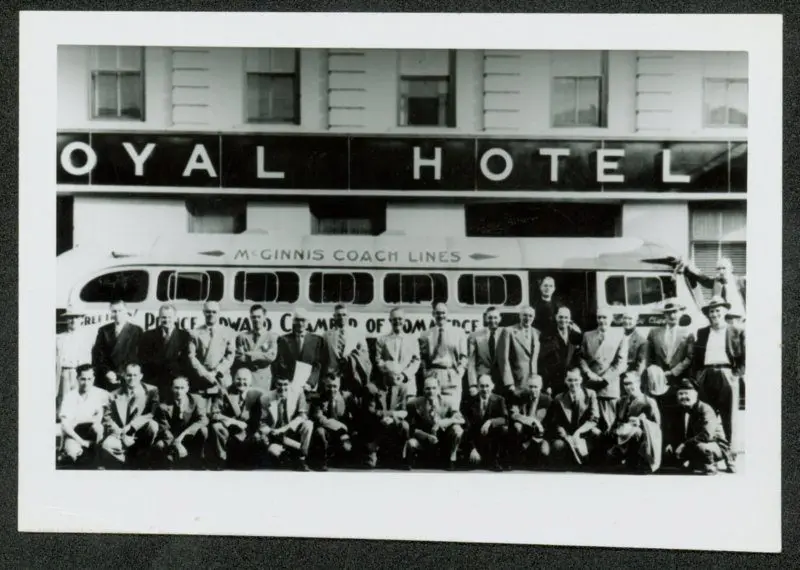Beginning in the 1830s, the colony of British North America began a whirlwind love affair with railways and canal building to open up the land to settlement, to promote trade and economic development, and in some instances, to ensure alternative military routes in case of American invasions. These massive infrastructure investments were considered status symbols by nearby communities, tangible signs of progress signalling a bright industrial future.
 The Murray Canal, built between 1882 – 1889, provided an alternative shipping route around the treacherous shoals of Prince Edward County in the great days of sail and steam. And after nearly a decade of heated community debate, Prince Edward County’s own railway line was completed in 1879 with the tracks ending at what is now Lake Street on the western edge of downtown Picton.
The Murray Canal, built between 1882 – 1889, provided an alternative shipping route around the treacherous shoals of Prince Edward County in the great days of sail and steam. And after nearly a decade of heated community debate, Prince Edward County’s own railway line was completed in 1879 with the tracks ending at what is now Lake Street on the western edge of downtown Picton.
Railways nurtured the creation of railway hotels – modern, luxurious establishments catering to upscale travellers – businessmen, wealthy visitors, and important dignitaries. In 1881, Jonathan Mottashed, an experienced Picton innkeeper, opened an impressive new business on Picton’s Main Street, The Royal Hotel. The new hotel was on the preferred north side of the street bathed in sunlight most of the day. It was an imposing brick building three stories high with ornate exterior details including an iron balcony along the full length of the building and an elaborate octagonal cupola that established The Royal as the dominant heritage fixture of the town’s skyline.
Inside the lobby, a grand, wooden staircase led to the spacious upstairs suites. Reception was immediately on the left. The dining room with its linen-covered tables and handsome cutlery was at the rear of the building. There was also an entrance to the popular tavern.
There were other hotels along Picton’s Main Street. Mottashed’s previous hotel, The North American, was perched at the top of the town hill, and boasted the longest bar in the area. The nearby Globe Hotel built in the mid – 1820s, served as the arrival and departure point for stage coach passengers. Every hamlet throughout the County offered at least rough lodgings with a watering hole to compensate for the poor food and limited accommodation. Heavy drinking was so widespread, businesses serving alcohol faced a persistent campaign from local churches and temperance advocates. Picton became “ground -zero” for the temperance movement as the hometown of temperance pioneer Letitia Youmans (1827 – 1896), who waged a life – long war against the liquor industry across the country. Ironically, the Prohibition era (1920 – 1933) only bolstered the booze business as local fishermen and entrepreneurs risked their lives against weather and the U.S. Coast Guard to run liquor into an insatiable American market.
Mottashed’s new enterprise was short-lived. The railway struggled financially. He had bet the bank on his new venture borrowing $18,000 for a mortgage. By 1883, the hotel was in trusteeship, and soon after, The Royal was under new management. Mottashed seems to have disappeared into the mists of time perhaps unable to recover from a mountain of debt. And in the decades which followed, the hotel’s fate mirrored the rise and fall of the local economy.
There were some good times. From 1860 to 1890, a period known as The Barley Days, county farmers shipped their lucrative grain harvests year – round across Lake Ontario to brewers in New York State. When that trade died, a new business canning fruits and vegetables began. Up until the late 1950s, Prince Edward County was such a dominant centre of the country’s canning industry, it was known as “the Garden County of Canada.”
 Friday and Saturday nights brought farmers to town to buy their groceries and other supplies, and to spend their hard-earned dollars on a rare luxury like a dinner at The Royal. The insatiable demand for food during two world wars brought boom times, which offset the ten lost years of the Great Depression. The construction of Camp Picton, a Commonwealth air training facility built in 1939, swelled the town’s population with a substantive military presence. These were the great days of The Royal as the hotel hosted dinners and dances, military balls, birthdays, weddings and anniversaries, election nights, and served as a meeting space for service clubs, warden’s banquets, and other community events.
Friday and Saturday nights brought farmers to town to buy their groceries and other supplies, and to spend their hard-earned dollars on a rare luxury like a dinner at The Royal. The insatiable demand for food during two world wars brought boom times, which offset the ten lost years of the Great Depression. The construction of Camp Picton, a Commonwealth air training facility built in 1939, swelled the town’s population with a substantive military presence. These were the great days of The Royal as the hotel hosted dinners and dances, military balls, birthdays, weddings and anniversaries, election nights, and served as a meeting space for service clubs, warden’s banquets, and other community events.
There were also some lean years. In the 1950s, the canning industry rationalized and shifted to the more fertile land and longer growing season of southwestern Ontario. Heinz built a new factory in Leamington, Ontario making that community the “Ketchup Capitol of Canada.” The military base closed in the mid-1960s, and the local economy struggled to recover from these devastating blows.
The great days of the Royal were also over. Hotel patrons were now a totally different clientele, and The Royal was a rough and tumble local tavern. In 2008, its sparse contents were auctioned and this landmark building was boarded up to begin a rusting retirement as a likely candidate for demolition, the fate of many County heritage properties during the period.
In September 2010, an 1875 former church on Picton’s Main Street was demolished, an event rated as one of the top ten heritage losses of that year by the National Heritage Trust of Canada. The demolition created a loud public outcry within a county that prides itself on its Loyalist roots. Yet, some good resulted from this shocking loss as it prompted local government to establish a Picton Heritage Conservation District in 2013. And it also prompted the Sorbara family to purchase the Royal, a neglected heritage treasure.

The Sorbara family are established Toronto developers and former Ontario Liberal finance minister, Greg Sorbara, had moved to a farm in the County with his family years earlier. As he walked by the ruins of the Royal one day, Sorbara felt strongly somebody should save the building. By the time he had walked its length, he concluded that “somebody” would have to be his family.
Extensive restoration of The Royal began in 2016. Without any maintenance in its retirement years, the building’s roof had allowed torrents of rain water to destroy the once elegant central staircase. The floors were unsafe and green mold now served as an eerie interior wallpaper. Restoration efforts were hampered by the collapse of the eastern brick wall of the building after heavy rains undermined its foundation. Despite the setbacks, the work continued. The Sorbara family purchased a nearby building that had once served as the horse stables for the hotel. Over subsequent years, they have purchased additional neighbouring heritage properties as part of their hotel project.
In December 2021, The Royal opened its doors again as a boutique hotel and dining complex.
Its restoration has helped establish a renewal of interest within the community in restoring – rather than demolishing – significant heritage properties. And its construction has coincided with a resurgence of the local economy through the establishment of wineries, breweries, restaurants, and visitor services making Prince Edward County a major tourism destination.
The stately Royal Hotel is once again a centrepiece of Picton’s Main Street.








